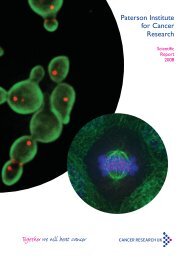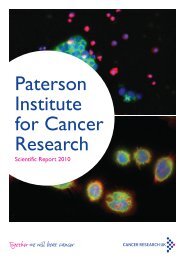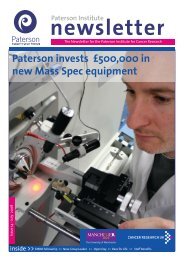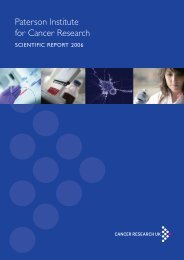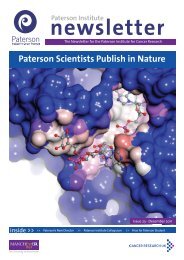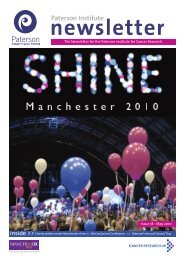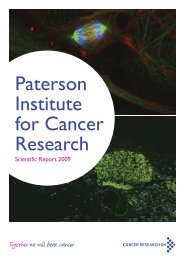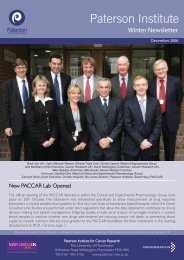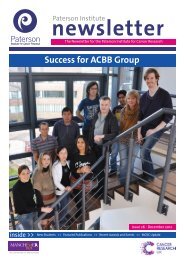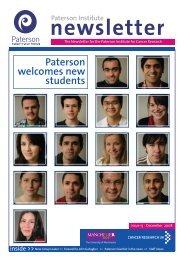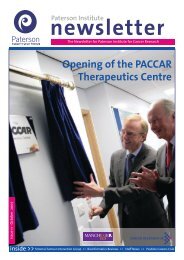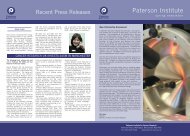Paterson Institute for Cancer Research SCIENTIFIC REPORT 2005
Paterson Institute for Cancer Research SCIENTIFIC REPORT 2005
Paterson Institute for Cancer Research SCIENTIFIC REPORT 2005
Create successful ePaper yourself
Turn your PDF publications into a flip-book with our unique Google optimized e-Paper software.
RESEARCH SERVICES<br />
To achieve these goals we have purchased new cameras,<br />
light sources and more specific fluorescent filters<br />
and mirrors to minimise light loss in transmission.<br />
In parallel we have been fine-tuning the cell<br />
environment on the microscope stage. The result<br />
has been a widespread increase in live cell imaging<br />
within the <strong>Institute</strong> and a decline in imaging fixed<br />
samples. In short, emphasis can now be given to<br />
the temporal dynamics of structural changes rather<br />
than simply cataloguing snapshots of the variety of<br />
<strong>for</strong>ms within a population.<br />
Multi-position time-lapse over the last year has<br />
become the all more important. Many events occur<br />
fairly infrequently, <strong>for</strong> example cell division can<br />
occur in a 40 minute window every 24 hours, and<br />
waiting <strong>for</strong> these events to occur in one field of<br />
view would be prohibitively slow. Visiting multiple<br />
points greatly enhances the return such that questions<br />
can be asked with multi-point visiting that<br />
would be impractical in single fields of view. We<br />
have there<strong>for</strong>e added a high resolution XYZ stage<br />
to our imaging plat<strong>for</strong>m. Several research groups<br />
within the institute are involved in these <strong>for</strong>ms of<br />
data collection on a weekly, if not daily basis.<br />
In the previous year we started developing systems<br />
<strong>for</strong> controlled spot-limited photo-bleaching. These<br />
techniques are now in routine use and have been<br />
employed with great effect to study polymer<br />
dynamics and the turnover of proteins on spindle<br />
poles by Iain Hagan’s laboratory. These time-lapse<br />
investigations are ongoing and are yielding in<strong>for</strong>mation<br />
about dynamics within bundles of microtubule<br />
polymers that are simply not possible to obtain<br />
from looking at the dynamics of an unbleached<br />
bundle.<br />
We are currently reviewing new fluorescent proteins<br />
and testing particular filter/dichroic mirror combinations<br />
to optimise transmission. We are also trying<br />
to exploit the potential of quantum dots as a<br />
labelling technology <strong>for</strong> both long term tissue sections<br />
to support target validation and clinical trials<br />
and <strong>for</strong> use in live cell imaging. It is hoped that<br />
quantum dot technology will be in routine use in<br />
both clinical and laboratory applications within a<br />
year.<br />
The increase in capabilities of the systems, in particular<br />
the multi-point visiting and photo-bleaching<br />
studies, are highlighting the need to keep the software<br />
and archiving in step with the developments in<br />
microscopes and cell culture. We are there<strong>for</strong>e<br />
planning measures to deal with this increase in<br />
dependence upon large scale computing plat<strong>for</strong>ms<br />
and high-end software over the next year and anticipate<br />
an increasing need <strong>for</strong> mathematical modelling<br />
of the biological phenomena we are documenting.<br />
____________________________________<br />
Biological Resources<br />
http://www.paterson.man.ac.uk/facilities/bru.jsp<br />
The Biological Resources unit continues to provide<br />
a modern integrated service, supporting scientific<br />
research programmes whilst ensuring that the highest<br />
quality of health and welfare are maintained at<br />
all times. The use of animals in medical research<br />
remains a controversial issue and although alternative<br />
methods such as tissue culture are used wherever<br />
possible, there is still a need <strong>for</strong> some research<br />
involving animals in the understanding of cancer<br />
and the development of better treatments <strong>for</strong><br />
patients. All the work at the <strong>Paterson</strong> <strong>Institute</strong> that<br />
involves the use of rodents is covered by licences<br />
issued by the Home Office and reviewed by a local<br />
ethical committee.<br />
Since 2004 we have brought in several new genetically<br />
altered strains of mice which are vital to keeping<br />
us at the <strong>for</strong>efront of the scientific research.<br />
Once they arrive within the BRU all the mice are<br />
housed in individually ventilated cages (IVCs); these<br />
cages prevent the spread of potential disease from<br />
one cage to another, with each cage having an individual<br />
Hepa filtered air supply and exhaust. In<br />
addition to protecting the mice from disease these<br />
cages also help to protect the staff from exposure<br />
to allergens from the mice and bedding. Exposure<br />
of staff to laboratory animal allergens (LAA) is a<br />
current hot topic with the Health and Safety<br />
Executive (HSE). Long term exposure to LAA can<br />
induce asthma and skin or eye allergies in staff handling<br />
the animals. The use of IVC caging dramatically<br />
reduces this risk. All the cages are provided<br />
with environmental enrichment, in the <strong>for</strong>m of<br />
nesting material and wooden chew blocks or play<br />
tunnels. The addition of these items to the cage<br />
provides environmental stimulation <strong>for</strong> the mice<br />
and reduces aggression amongst males of some<br />
strains. We undertake routine health screening<br />
from our colonies to ensure that the mice are free<br />
from a list of specific pathogens (SPF) and any new<br />
strains brought into the unit are health-screened<br />
be<strong>for</strong>e introduction into the facility.<br />
Two thirds of the space in the unit has been given<br />
over to the development and breeding of genetical-<br />
P A T E R S O N I N S T I T U T E S C I E N T I F I C R E P O R T 2 0 0 5<br />
51



